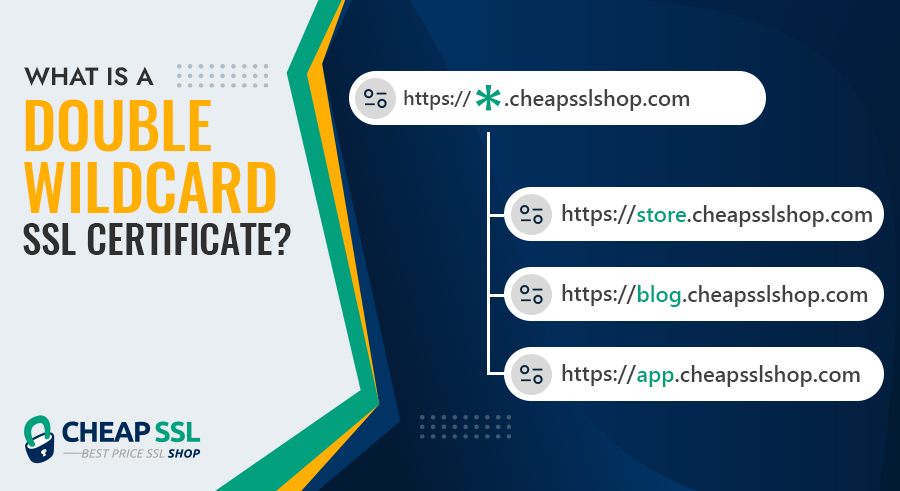While exploring options to manage multiple levels of subdomains, you may have come across the term “Double Wildcard SSL Certificate.” While it sounds like a flexible solution for deeper domain structures, in reality, Double Wildcard SSL does not exist.
This blog will help you understand what a Double Wildcard really means and how it differs from a Standard Wildcard SSL. It will also debunk the myth and offer practical SSL solutions that meet your security needs.
This blog is for:
- Web developers building multi-level subdomain-based platforms
- System administrators securing internal and public environments
- Business owners with growing digital infrastructure
- Agencies managing SSL for client websites
Understanding a Wildcard SSL Certificate and its Coverage
A Wildcard SSL Certificate is designed to secure a primary domain and all of its first-level subdomains using a single certificate. However, Wildcard SSL does NOT cover second-level or deeper subdomains.
Wildcard certificates are a type of X.509 certificate, where the domain name (Common Name and SAN entries) uses a ‘*’ to represent a single label to the left of the registered domain.
Covered: First-Level Subdomains
- www.cheapsslshop.com
- blog.cheapsslshop.com
- store.cheapsslshop.com
Not Covered: Nested Subdomains
- login.blog.cheapsslshop.com
- secure.store.cheapsslshop.com
- sub.dev.cheapsslshop.com
Browsers and clients perform strict hostname validation during the TLS handshake. If the hostname doesn’t match the certificate’s CN/SAN, users get an SSL certificate mismatch error.
Why Do People Search for “Double Wildcard SSL”?
People often search for this term when they need SSL coverage for subdomains of subdomains. The misconception arises when users think they can get an SSL to cover all subdomain levels using a single certificate.
Technically, a “Double Wildcard SSL Certificate” is not a real certificate type. It’s a term often used to describe the need to secure multiple wildcard levels – like
- subdomain2.subdomain1.cheapsslshop.com
- subdomain3.subdomain2.subdomain1.cheapsslshop.com
You’ll never find a Certificate Authority (CA) issuing a certificate for *.*.example.com – it’s not permitted by SSL standards or validation practices. The term “Double Wildcard SSL” is unofficial and not supported by any public CA due to
- Violation of CA/B Forum Baseline Requirements
- Wildcard limitation to a single domain label
- Security risks due to excessive exposure
In reality, a standard wildcard SSL certificate only secures the first-level subdomains and not the nested ones. So, while the term “double wildcard” isn’t officially valid, the need behind it is real.
Best Alternatives to a Double Wildcard SSL
-
Multi-Domain Wildcard SSL Certificate – The Most Ideal Option
A Multi-Domain Wildcard SSL Certificate combines the flexibility of wildcard coverage with the SAN (Subject Alternative Name) feature found in multi-domain certificates. You can list multiple wildcard domain patterns in the SAN field of a single certificate. Each wildcard entry secures a separate branch of subdomains.
Example SAN entries:
- *.example.com
- *.blog.example.com
- *.store.example.com
This setup allows you to secure:
- mail.example.com, login.example.com
- news.blog.example.com, media.blog.example.com
- checkout.store.example.com, offers.store.example.com
Technical Advantages:
- Single certificate & key pair for multiple wildcard domains
- Reduces SSL installation and renewal overhead
- Compatible with all modern browsers and servers
- Ideal for clustered or multi-tenant environments
Neglecting proper SSL security can lead to security vulnerabilities and user distrust. Proper SSL protection is essential to secure your multi-level subdomains from cyber threats. Get a Multi-Domain Wildcard Certificate from trusted CAs like Sectigo Multi-Domain Wildcard SSL, Comodo Multi-Domain Wildcard SSL, and PositiveSSL Multi-Domain Wildcard SSL, and secure your main domain with unlimited multiple level subdomains. -
Separate Wildcard SSL Certificates – A Workable Option
Another technically sound option is to deploy individual wildcard SSL certificates for each required subdomain level.
Example Configuration:
- *.example.com → covers mail.example.com, login.example.com
- *.blog.example.com → covers news.blog.example.com, media.blog.example.com
Side-by-Side Comparison: Multi-Domain Wildcard vs. Standard Wildcard
| Feature | Multi-Domain Wildcard SSL | Standard Wildcard SSLs |
|---|---|---|
| Covers multiple wildcard domains | Yes (in SAN field) | One wildcard domain per cert |
| Single certificate management | Simplified | Multiple certs to manage |
| Flexibility | Highly flexible | Modular and targeted |
| Ideal for multi-level subdomains | Yes | Yes (with multiple wildcard certs) |
| Cost-efficiency | More economical for scale | Higher cost at scale |
Choosing the Right SSL for Your Needs
- If you need multiple wildcard domains → Go for a Multi-Domain Wildcard SSL.
- If you need full control over each subdomain level → Get Multiple Wildcard SSL.
- If you only need first-level subdomains → Choose a Wildcard SSL.
Conclusion
A Double Wildcard SSL Certificate may not be a real SSL product, but the need behind it is valid. If you’re looking to secure subdomains at different levels, you have trusted and scalable options available. Whether it’s a Wildcard SSL or Multi-Domain Wildcard, CheapSSLShop offers a wide range of affordable SSL certificates tailored to your security needs.
Related Posts:


